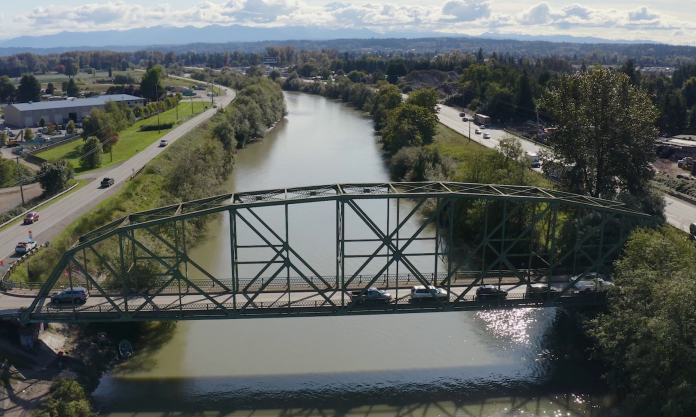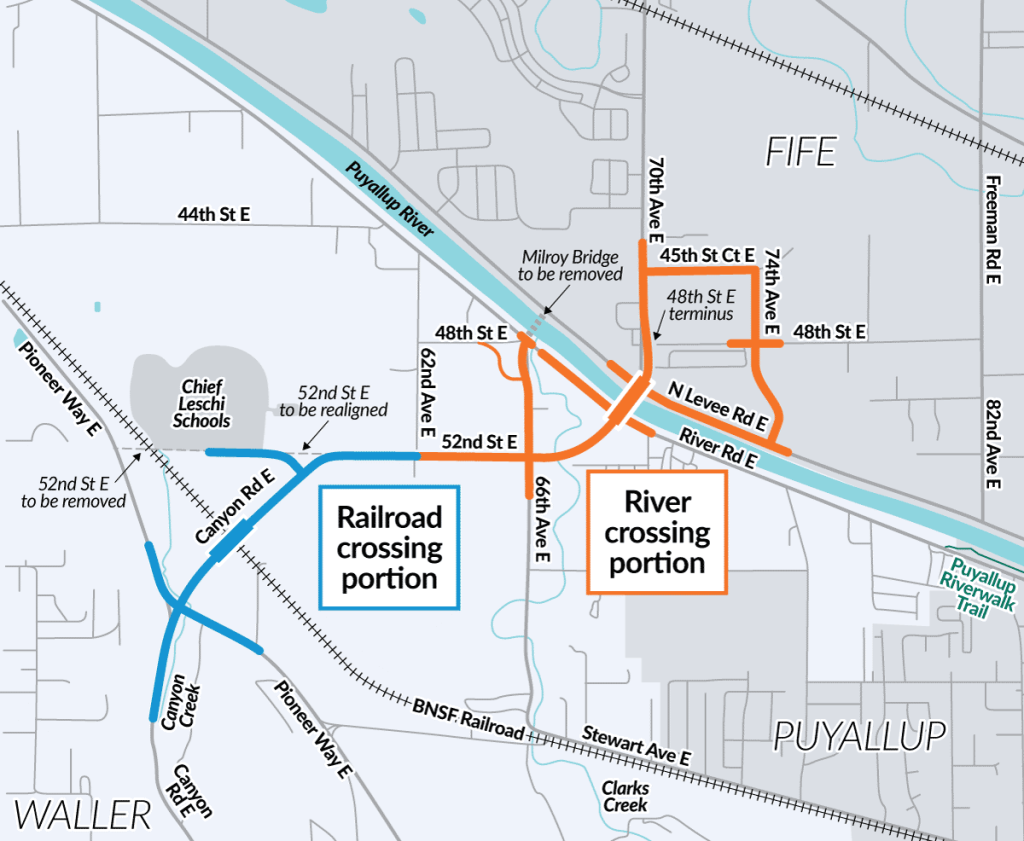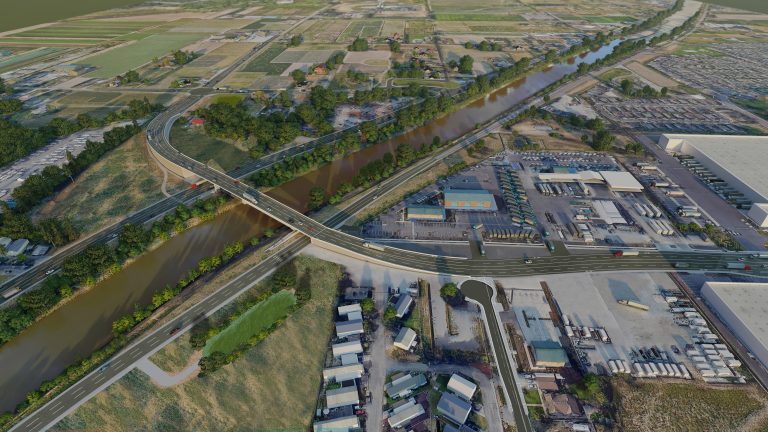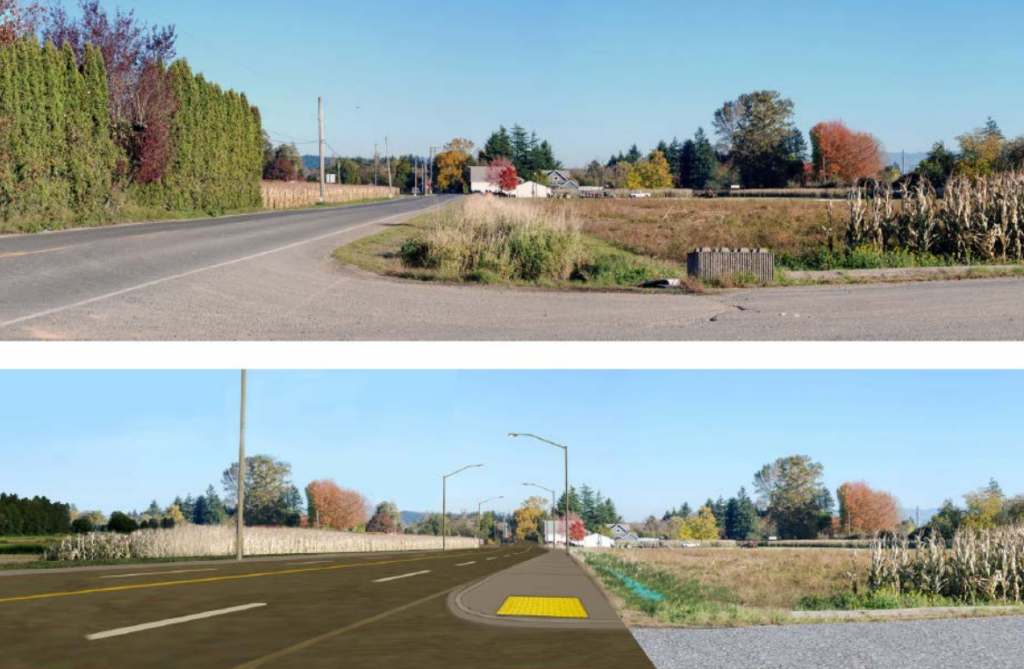
As the Washington State Department of Transportation (WSDOT) moves forward on construction of the extension of SR 167 to the Port of Tacoma in Pierce County, elected officials on the Pierce County Council are voicing skepticism that even more roadway expansion in the area is actually aligned with the county’s goals and should take precedent over other spending priorities. Their skepticism could put the brakes on another project, the extension of Canyon Road south of Fife, which has been rubber stamped by county staff since the mid 1990s.
Last week, four Pierce County councilmembers voted against pursuing a $30 million grant that would fund a portion of the Canyon Road extension. Framed as the “final piece” of a corridor that Pierce County has spent many years expanding, right now construction is underway on widening the street from three to five lanes between 84th Street E and 72nd Street E. That work only leaves a short segment left to expand before the end of Canyon Road, with plans on the books for decades to extend Canyon Road over the Puyallup River into Fife.
The grant being sought would fund the grade separation of the roadway from the BNSF railway line near Pioneer Way. But the full extension of the roadway remains unfunded, with a new estimated cost of $250 million to $300 million, and only around $50 million currently identified as available, apart from this grant. Multiple councilmembers signaled that their no vote was a direction to county staff to go back and rethink the Canyon Road project.

“I feel like committing future councils to tens of millions of dollars in spending just because this is what we have been doing for the last couple decades without doing some additional analysis is irresponsible,” Council Chair Derek Young said at a meeting in late September. “We have priorities elsewhere in the county that we need to support, we have transportation needs, we were just talking earlier about transportation needs that the council has not met in the past and that’s largely because we have been socketed into one large project.”
Young has repeatedly suggested that the Canyon Road project needs to be “skinnied down,” and he was joined in the most substantive pushback on the project by Councilmember Ryan Mello.
“The transportation, financial, and environmental analysis on this project has not been updated since 1997,” Mello said at the same September meeting. “We have really significantly old analysis and I hear all the time from my colleagues about how they need funds to do safety projects, capacity projects and have many many needs throughout the county. And committing $58 million to this one project, based on analysis that was done in 1997, just doesn’t make fiscal sense to me. We’re just continuing to go down the path because in 1995, in 1997, someone said this was the best idea ever.”
The planned September vote was postponed but not much had changed by the time it was back at the County Council in early October.
Mello returned to the issue of using plans from the 1990s at the October meeting. “Since then, the region and the state have rallied and approved funding for the new [SR] 167 which is designed to move freight traffic….we’re investing over a billion dollars of local and state resources into the new 167 to move freight traffic. I keep hearing that Canyon Road is needed based on 1990s environmental analysis, yet we’re spending a billion dollars on the new 167…let’s use that to move freight traffic.” He also raised health concerns over adding a five lane highway immediately adjacent to the nearby Chief Leschi Schools.

Councilmember Jani Hitchin was less skeptical of the overall project but joined Young and Mello in wanting to get a lot more details on the next steps for the expansion of Canyon Road.
“This is one of the projects that I think there’s too many questions right now…there are still some fuzzy details that are being ironed out that I am concerned will then waste dollars, waste time or increase costs, and I’m not willing with a $300 million project — maybe — to waste anything,” she said.
Hitchin brought up the Cross Base Highway, a failed project to build a state highway across Joint Base Lewis-McChord that fell apart after years of work when the legislature prioritized projects elsewhere, and worried aloud that the county could end up building a part of the project and not be able to complete the rest.

Councilmember Marty Cambell, the fourth no vote, and representative for the district where the Canyon Road project is located, joined his colleagues in asking for a reset.
“Something has to be done. But there’s a lot of concern across the council and in the community that the current plan isn’t right, and that it needs tweaks. But we keep moving it forward to fund the program saying, ‘gee, we really can’t tweak it’,” he said.
On the pro-expansion side, Councilmember Amy Cruver framed separating the roadway from the railroad tracks as being an important investment in safety, tying it back to a resolution that the County Council passed earlier this year that committed to eliminating traffic fatalities and serious injuries by 2035.
Cruver, however, had voted against that resolution, at the time suggesting Vision Zero was part of an “international plan” to change how people live their lives. And there was also near unanimity among the councilmembers that the grade separation project should still happen, just disagreement over whether it should be tied to a five lane roadway expansion.

Cruver also suggested the project would reduce greenhouse gas emissions by reducing idling. Other councilmembers didn’t directly engage with this argument, but the day after the vote, Councilmember Mello tweeted, “Debunking Myths: No, the old-school thought of limiting idling through highway expansions do not get you out of traffic and certainly does NOT decrease green house gas emissions. It increases them.” Mello included a link to a 2017 article from Streetsblog debunking the idea that roadway expansion will decrease emissions.
“
Pierce County as whole, on the other hand, has actually been open about the idea that the project will increase traffic and local pollution.
“Because the project is likely to provide a more efficient route between the Port of Tacoma and the Frederickson Manufacturing Industrial Center, it will probably increase local traffic, and local pollutants,” a presentation shown on the project read earlier this year. “But regionally, air quality should improve as overall vehicles travel fewer miles.”
That second part is fairly dubious, as housing production in exurban Pierce County continues to grow while transit service expansion lags behind. Between 2010 and 2020, 83% of the units of added housing in Pierce County were located entirely outside of designated growth centers and away from high capacity transit. Keeping those growth patterns in mind, expanding a major roadway through east Pierce County is thus likely to increase overall vehicle miles traveled.
With the project is blocked for now, this fall’s elections will decide whether it stays that way. Chair Derek Young is leaving office, and Councilmember Campbell is also up for reelection. With the County Council this divided, a change of direction of just one seat could make the difference.
The expansion of the Canyon Road project is unlikely to be put back on the shelf entirely. But the pushback on a zombie road project from three decades ago signals an increasing recognition that expensive mega-projects like the Canyon Road expansion come with real consequences on the rest of the transportation system by preventing other badly needed investments from happening.
Ryan Packer has been writing for The Urbanist since 2015, and currently reports full-time as Contributing Editor. Their beats are transportation, land use, public space, traffic safety, and obscure community meetings. Packer has also reported for other regional outlets including BikePortland, Seattle Met, and PubliCola. They live in the Capitol Hill neighborhood of Seattle.

